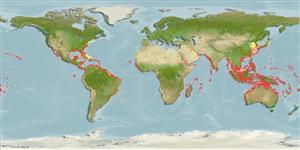分類 / Names
共通名の | 類義語 | Catalog of Fishes(部類, 種) | ITIS | CoL | WoRMS | Cloffa
板鰓亜鋼(サメとエイ類) (sharks and rays) >
Myliobatiformes (Stingrays) >
Aetobatidae (Pacific eagle rays)
Etymology: Aetobatus: Greek, aetos = eagle + Greek, batis, batidos = a ray (Raja sp.) (Ref. 45335).
Issue
Status of Aetobatus latirostris Duméril, 1861 requires further investigation. Species information (common names) should be linked to correct species (see Ref. 114963).
Environment: milieu / climate zone / depth range / distribution range
生態学
海; 汽水性の 底生の漂泳性; 両側回遊性 (Ref. 51243); 深さの範囲 1 - 80 m (Ref. 9710). Subtropical; 36°N - 24°S, 98°W - 15°E
Western Atlantic and probably Eastern Atlantic. Indo-Pacific species refer to Aetobatus ocellatus; Eastern Pacific species refers to A. laticeps.
Length at first maturity / サイズ / 重さ / 年齢
Maturity: Lm 107.4, range 110 - 120 cm
Max length : 230 cm WD オス/雌雄の選別がない; (Ref. 114953); common length : 140 cm WD オス/雌雄の選別がない; (Ref. 114953); 最大公表体重: 230.0 kg (Ref. 7251)
簡単な記述
形態学 | 形態計測学
背面の脊椎 (合計): 0; 背鰭 (合計): 0; 肛門の骨 0; 臀鰭: 0. An eagleray with a long snout, flat and rounded like a duck's bill, a thick head, and a pectoral disc with sharply curved, angular corners, and no caudal fin; jaws usually with single row of flat, chevron-shaped teeth (Ref. 5578). Each tooth a crescent-shaped plate joined into a band (Ref. 26938). Numerous white spots on black or bluish disc; white below (Ref. 5578). Long whiplike tail, with a long spine near the base, behind small dorsal fin. No spines on disk (Ref. 7251).
Commonly found in coastal habitats to at least 60 m depth (Ref. 114953). Swims close to the surface, occasionally leaping out of the water, or close to the bottom (Ref. 3175). Frequently forming large schools during the non-breeding season (Ref. 7251). Feeds on polychaetes, bivalves, gastropods, cepahlopods, shrimps and small fishes (Ref. 114953). Ovoviviparous (Ref. 50449). Bears young in litters of 2-4 (Ref. 26938, 114953).
Life cycle and mating behavior
成熟 | 繁殖 | 放精 | 卵 | 生産力 | 幼生
Exhibit ovoviparity (aplacental viviparity), with embryos feeding initially on yolk, then receiving additional nourishment from the mother by indirect absorption of uterine fluid enriched with mucus, fat or protein through specialised structures (Ref. 50449). Bears up to 4 young (Ref. 5578, 6871, 37816). Width at birth 17-35 cm (Ref. 37816).
According to Uchida et al (1990) (Ref. 51119) 'the male chases the female in mid water, then nibbles on her dorsal surface. The female stops swimming to begin copulation. The male bites the female on a pectoral fin and bends one clasper forward, then attempts an abdomen to abdomen copulation with either clasper, usually mid-water' (Ref. 49562). Copulation lasted for 20 seconds to 1 minute (Ref. 49562).
Last, P.R., W.T. White, M.R. de Carvalho, B. Séret, M.F.W. Stehmann and G.J.P. Naylor, 2016. Rays of the world. CSIRO Publishing, Comstock Publishing Associates. i-ix + 1-790. (Ref. 114953)
IUCNのレッドリストの状況は (Ref. 130435)
絶滅危惧 (EN) (A2bd); Date assessed: 28 July 2020
人間に対する脅威
Traumatogenic (Ref. 4690)
Human uses
水産業: 少数商業の
より多くの情報
参考文献水産養殖水産養殖の紹介緊張遺伝子のElectrophoreses遺伝病気行列NutrientsMass conversion
用具
特記事項
XMLをダウンロードして下さい
インターネットの情報源
Estimates based on models
Preferred temperature (Ref.
123201): 22.3 - 29, mean 27.5 °C (based on 4014 cells).
Phylogenetic diversity index (Ref.
82804): PD
50 = 0.6250 [Uniqueness, from 0.5 = low to 2.0 = high].
Bayesian length-weight: a=0.01000 (0.00244 - 0.04107), b=3.04 (2.81 - 3.27), in cm total length, based on all LWR estimates for this body shape (Ref.
93245).
栄養段階 (Ref.
69278): 4.2 ±0.1 se; based on diet studies.
回復力 (Ref.
120179): 非常に低い, 14年以上の倍増期間の最小個体群 (tm=4-6; Fec=1-2).
Prior r = 0.06, 95% CL = 0.04 - 0.10, Based on 1 stock assessment.
Fishing Vulnerability (Ref.
59153): Very high vulnerability (85 of 100).
Nutrients (Ref.
124155): Calcium = 9.92 [1.89, 44.45] mg/100g; Iron = 0.495 [0.123, 1.361] mg/100g; Protein = 22 [17, 27] %; Omega3 = 0.253 [0.077, 0.713] g/100g; Selenium = 25.2 [7.7, 73.8] μg/100g; VitaminA = 8.16 [2.83, 22.84] μg/100g; Zinc = 0.526 [0.255, 0.991] mg/100g (wet weight);
